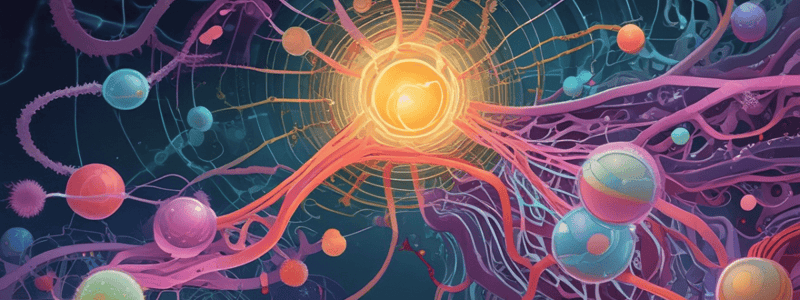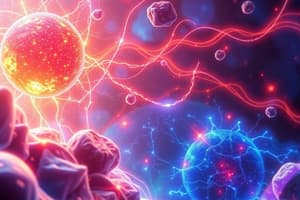Podcast
Questions and Answers
Match the following stages of metabolic pathway evolution with their corresponding energy sources:
Match the following stages of metabolic pathway evolution with their corresponding energy sources:
Glycolysis = Preformed organic molecules (e.g. glucose) Photosynthesis = Energy from sunlight Oxidative metabolism = Oxygen (O2) ATP energy pathway = Sunlight and glucose
Match the following molecules with their roles in metabolic pathways:
Match the following molecules with their roles in metabolic pathways:
ATP = Source of energy for metabolic reactions CO2 = Starting material for organic molecule synthesis H2S = Electron acceptor in photosynthesis H2O = Source of energy for glycolysis
Match the following metabolic pathways with their outcomes:
Match the following metabolic pathways with their outcomes:
Glycolysis = Conversion of glucose to ATP Photosynthesis = Production of oxygen (O2) Oxidative metabolism = Use of oxygen (O2) for energy ATP energy pathway = Synthesis of organic molecules
Match the following molecules with their roles in photosynthesis:
Match the following molecules with their roles in photosynthesis:
Match the following stages of metabolic pathway evolution with their corresponding environmental impacts:
Match the following stages of metabolic pathway evolution with their corresponding environmental impacts:
Match the following metabolic pathways with their energy yield:
Match the following metabolic pathways with their energy yield:
Match the following statements about oxidative metabolism with their corresponding descriptions:
Match the following statements about oxidative metabolism with their corresponding descriptions:
Match the following characteristics of prokaryotes with their corresponding descriptions:
Match the following characteristics of prokaryotes with their corresponding descriptions:
Match the following types of organisms with their corresponding environments:
Match the following types of organisms with their corresponding environments:
Match the following energy-related processes with their corresponding ATP yields:
Match the following energy-related processes with their corresponding ATP yields:
Match the following statements about prokaryotes with their corresponding timeframes:
Match the following statements about prokaryotes with their corresponding timeframes:
Match the following types of prokaryotes with their corresponding characteristics:
Match the following types of prokaryotes with their corresponding characteristics:
Match the following organelles with their functions in eukaryotic cells:
Match the following organelles with their functions in eukaryotic cells:
Match the following cellular components with their characteristics:
Match the following cellular components with their characteristics:
Match the following eukaryotic cell features with their advantages:
Match the following eukaryotic cell features with their advantages:
Match the following cellular structures with their functions:
Match the following cellular structures with their functions:
Match the following eukaryotic cell features with their benefits:
Match the following eukaryotic cell features with their benefits:
Match the following eukaryotic cell features with their characteristics:
Match the following eukaryotic cell features with their characteristics:
Flashcards are hidden until you start studying
Study Notes
Cellular Energy Evolution
- Cells developed mechanisms to generate energy and synthesize replication molecules through metabolic pathways utilizing ATP.
- ATP production evolved through three stages: glycolysis, photosynthesis, and oxidative metabolism.
Glycolysis and Photosynthesis
- Glycolysis transforms energy from organic molecules, like glucose, into ATP for various metabolic reactions.
- Photosynthesis allowed cells to capture sunlight energy, reducing dependence on glucose.
- First photosynthetic bacteria emerged over 3 billion years ago, employing H2S to convert CO2 into organic compounds.
- Water use in photosynthesis generates oxygen as a byproduct, significantly increasing atmospheric oxygen levels.
Impact of Oxygen on Metabolism
- The rise in atmospheric oxygen, due to photosynthesis, led to the evolution of oxidative metabolism.
- Oxidative metabolism provides a more efficient energy production method than anaerobic glycolysis, leveraging reactive oxygen for energy extraction.
Eubacteria and Eukaryotes
- Eubacteria represent diverse organisms thriving in various environments, including soil and water.
- Eukaryotic cells are more complex, featuring a nucleus, organelles, and a cytoskeleton, unlike prokaryotic cells.
- The nucleus, containing linear genetic material, is vital for DNA replication and RNA synthesis; ribosomes translate RNA into proteins.
Organelles in Eukaryotes
- Eukaryotes contain membrane-enclosed organelles crucial for localized metabolic activities, enhancing function efficiency.
- Mitochondria are critical for energy metabolism, converting glucose into ATP through oxidative processes.
- Chloroplasts, although not detailed, are integral to photosynthesis in plant cells.
Oxidative Metabolism Evolution
- The relationship between oxidative metabolism and photosynthesis is debated; some argue oxidative processes predate photosynthesis due to atmospheric changes favoring oxygen-utilizing organisms.
- Complete oxidative breakdown of glucose produces 36-38 ATP compared to just 2 ATP from anaerobic glycolysis.
Prokaryotic Origins
- Prokaryotes, the earliest forms of life, are still represented by modern bacteria, with fossils dating back to approximately 3.4 billion years.
- All life is believed to have evolved from prokaryotic ancestors, with a timeline of 3.5 to 4.0 billion years.
- Current prokaryotes are categorized into two groups: Archaebacteria and Eubacteria.
- Archaebacteria thrive in extreme conditions, such as high-temperature, low pH environments like hot sulfur springs.
Studying That Suits You
Use AI to generate personalized quizzes and flashcards to suit your learning preferences.




